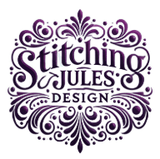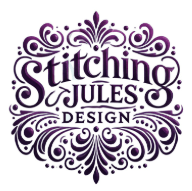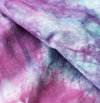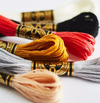Cross-stitch is typically done on fabrics that have an even, grid-like weave to make it easier to create uniform stitches. Here’s a breakdown of the main types of fabric used for cross-stitch and their characteristics:
🧵 1. Aida Cloth (Most Common)
- Description: Aida is a woven fabric with a clearly defined grid, making it the most beginner-friendly fabric for cross-stitch.
- Count: Typically available in 11, 14, 16, and 18 counts (the number of squares/holes per inch).
- Best For: Beginners or detailed designs that require visible holes.
-
Popular Types:
- White, black, or colored Aida
- Hand-dyed Aida for unique effects
Pros:
✅ Easy to see holes
✅ Stiff enough to work without a hoop
Cons:
❌ Can be too stiff for some projects
❌ Limited to more structured designs
Where can you find Aida Fabric Online?
🧵 2. Evenweave Fabric
- Description: Evenweave fabric has the same number of horizontal and vertical threads, giving a smooth and even surface. It’s softer than Aida but more challenging to work with.
- Count: Typically 25 to 32 count.
- Best For: More advanced stitchers, detailed and elegant designs.
Pros:
✅ More refined, less “blocky” look
✅ Great for fractional stitches and finer details
Cons:
❌ Harder to see holes
❌ Requires more experience
🧵 3. Linen
- Description: Linen is a natural fabric with a slightly uneven texture. It’s favored by experienced cross-stitchers for its elegant appearance.
- Count: Usually 28 or 32 count.
- Best For: Vintage or high-end cross-stitch designs.
Pros:
✅ Beautiful, sophisticated finish
✅ Suitable for heirloom-quality projects
Cons:
❌ More difficult to work with due to uneven weave
❌ Expensive
🧵 4. Perforated Paper
- Description: A heavy cardstock with evenly spaced holes for stitching. It’s a unique option for creating items like cards, bookmarks, or ornaments.
- Count: Usually 14 count.
- Best For: Non-traditional projects like greeting cards or Christmas ornaments.
Pros:
✅ No need to finish edges
✅ Easy to frame
Cons:
❌ Fragile and prone to tearing
❌ Limited flexibility
🧵 5. Plastic Canvas
- Description: A stiff, plastic grid used for cross-stitch projects that need more durability, such as coasters, keychains, or decorations.
- Count: Usually 7 or 14 count.
- Best For: 3D projects and items that need structure.
Pros:
✅ Durable and water-resistant
✅ No need for finishing edges
Cons:
❌ Less traditional look
❌ Limited color options
🧵 6. Hardanger Fabric
- Description: A type of evenweave fabric used for both cross-stitch and Hardanger embroidery. It’s known for its durability and ability to support cutting and pulling threads.
- Count: Typically 22 count.
- Best For: Hardanger embroidery or advanced cross-stitch designs.
Pros:
✅ Ideal for intricate embroidery styles
✅ Holds its shape well
Cons:
❌ Not beginner-friendly
❌ Requires special techniques
🧵 7. Waste Canvas
- Description: A temporary fabric used to cross-stitch on non-traditional fabrics like T-shirts, jeans, or other clothing. Once stitched, the canvas is removed by pulling out the threads.
- Count: Available in various counts, usually 10 to 14.
- Best For: Stitching on clothes or non-standard surfaces.
Pros:
✅ Allows you to cross-stitch on almost any fabric
✅ Easy to remove after stitching
Cons:
❌ Time-consuming to remove the canvas
❌ Requires precision
🧵 8. Lugana Fabric
- Description: A blend of cotton and rayon that is smooth and durable, making it an excellent choice for cross-stitch and embroidery.
- Count: Commonly 25, 28, or 32 count.
- Best For: Projects with a delicate and elegant finish.
Pros:
✅ Soft and easy to work with
✅ Ideal for advanced designs
Cons:
❌ More expensive than Aida
❌ Less structured than Aida
✅ Summary Chart of Fabric Types
| Fabric Type | Common Count | Best For | Difficulty | Texture |
|---|---|---|---|---|
| Aida Cloth | 11-18 | Beginners | Easy | Stiff |
| Evenweave | 25-32 | Detailed designs | Intermediate | Soft |
| Linen | 28-32 | Elegant projects | Advanced | Natural |
| Perforated Paper | 14 | Cards/Ornaments | Easy | Cardstock |
| Plastic Canvas | 7-14 | 3D projects | Easy | Stiff/Plastic |
| Hardanger Fabric | 22 | Hardanger embroidery | Advanced | Durable |
| Waste Canvas | 10-14 | Clothing projects | Intermediate | Temporary |
| Lugana | 25-32 | Delicate designs | Intermediate | Smooth |
Let me know if you'd like more details on how to choose the right fabric for your project! 😊







